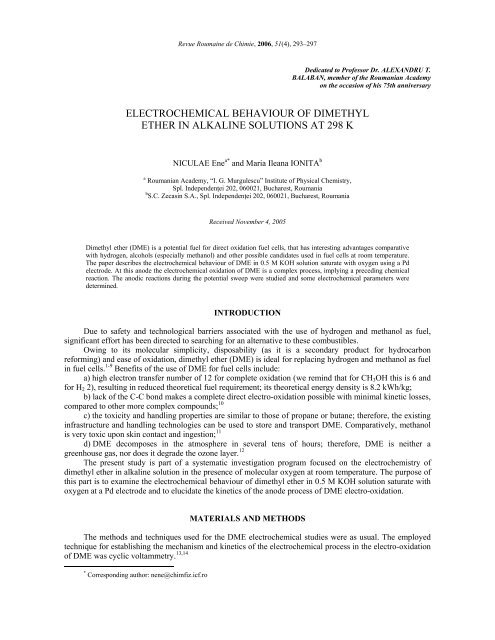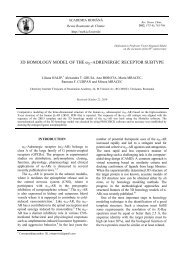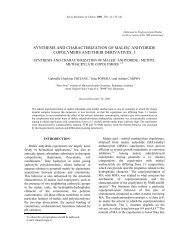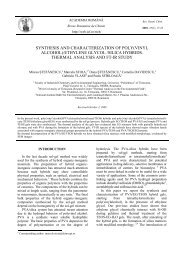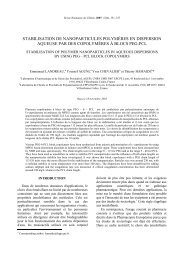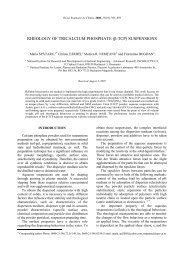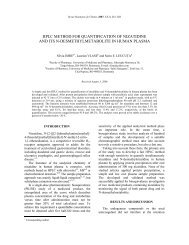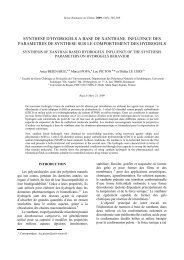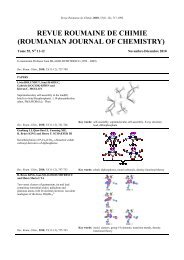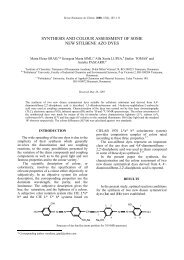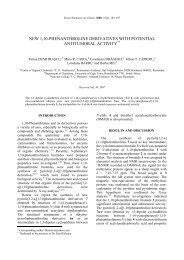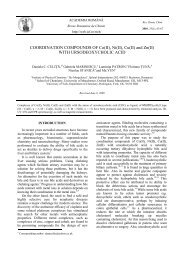electrochemical behaviour of dimethyl ether in alkaline solutions at ...
electrochemical behaviour of dimethyl ether in alkaline solutions at ...
electrochemical behaviour of dimethyl ether in alkaline solutions at ...
Create successful ePaper yourself
Turn your PDF publications into a flip-book with our unique Google optimized e-Paper software.
Revue Rouma<strong>in</strong>e de Chimie, 2006, 51(4), 293–297Dedic<strong>at</strong>ed to Pr<strong>of</strong>essor Dr. ALEXANDRU T.BALABAN, member <strong>of</strong> the Roumanian Academyon the occasion <strong>of</strong> his 75th anniversaryELECTROCHEMICAL BEHAVIOUR OF DIMETHYLETHER IN ALKALINE SOLUTIONS AT 298 KNICULAE Ene a* and Maria Ileana IONITA ba Roumanian Academy, “I. G. Murgulescu” Institute <strong>of</strong> Physical Chemistry,Spl. Independenţei 202, 060021, Bucharest, Roumaniab S.C. Zecas<strong>in</strong> S.A., Spl. Independenţei 202, 060021, Bucharest, RoumaniaReceived November 4, 2005Dimethyl <strong>ether</strong> (DME) is a potential fuel for direct oxid<strong>at</strong>ion fuel cells, th<strong>at</strong> has <strong>in</strong>terest<strong>in</strong>g advantages compar<strong>at</strong>ivewith hydrogen, alcohols (especially methanol) and other possible candid<strong>at</strong>es used <strong>in</strong> fuel cells <strong>at</strong> room temper<strong>at</strong>ure.The paper describes the <strong>electrochemical</strong> <strong>behaviour</strong> <strong>of</strong> DME <strong>in</strong> 0.5 M KOH solution s<strong>at</strong>ur<strong>at</strong>e with oxygen us<strong>in</strong>g a Pdelectrode. At this anode the <strong>electrochemical</strong> oxid<strong>at</strong>ion <strong>of</strong> DME is a complex process, imply<strong>in</strong>g a preced<strong>in</strong>g chemicalreaction. The anodic reactions dur<strong>in</strong>g the potential sweep were studied and some <strong>electrochemical</strong> parameters weredeterm<strong>in</strong>ed.INTRODUCTIONDue to safety and technological barriers associ<strong>at</strong>ed with the use <strong>of</strong> hydrogen and methanol as fuel,significant effort has been directed to search<strong>in</strong>g for an altern<strong>at</strong>ive to these combustibles.Ow<strong>in</strong>g to its molecular simplicity, disposability (as it is a secondary product for hydrocarbonreform<strong>in</strong>g) and ease <strong>of</strong> oxid<strong>at</strong>ion, <strong>dimethyl</strong> <strong>ether</strong> (DME) is ideal for replac<strong>in</strong>g hydrogen and methanol as fuel<strong>in</strong> fuel cells. 1-9 Benefits <strong>of</strong> the use <strong>of</strong> DME for fuel cells <strong>in</strong>clude:a) high electron transfer number <strong>of</strong> 12 for complete oxid<strong>at</strong>ion (we rem<strong>in</strong>d th<strong>at</strong> for CH 3 OH this is 6 andfor H 2 2), result<strong>in</strong>g <strong>in</strong> reduced theoretical fuel requirement; its theoretical energy density is 8.2 kWh/kg;b) lack <strong>of</strong> the C-C bond makes a complete direct electro-oxid<strong>at</strong>ion possible with m<strong>in</strong>imal k<strong>in</strong>etic losses,compared to other more complex compounds; 10c) the toxicity and handl<strong>in</strong>g properties are similar to those <strong>of</strong> propane or butane; therefore, the exist<strong>in</strong>g<strong>in</strong>frastructure and handl<strong>in</strong>g technologies can be used to store and transport DME. Compar<strong>at</strong>ively, methanolis very toxic upon sk<strong>in</strong> contact and <strong>in</strong>gestion; 11d) DME decomposes <strong>in</strong> the <strong>at</strong>mosphere <strong>in</strong> several tens <strong>of</strong> hours; therefore, DME is neither agreenhouse gas, nor does it degrade the ozone layer. 12The present study is part <strong>of</strong> a system<strong>at</strong>ic <strong>in</strong>vestig<strong>at</strong>ion program focused on the electrochemistry <strong>of</strong><strong>dimethyl</strong> <strong>ether</strong> <strong>in</strong> alkal<strong>in</strong>e solution <strong>in</strong> the presence <strong>of</strong> molecular oxygen <strong>at</strong> room temper<strong>at</strong>ure. The purpose <strong>of</strong>this part is to exam<strong>in</strong>e the <strong>electrochemical</strong> <strong>behaviour</strong> <strong>of</strong> <strong>dimethyl</strong> <strong>ether</strong> <strong>in</strong> 0.5 M KOH solution s<strong>at</strong>ur<strong>at</strong>e withoxygen <strong>at</strong> a Pd electrode and to elucid<strong>at</strong>e the k<strong>in</strong>etics <strong>of</strong> the anode process <strong>of</strong> DME electro-oxid<strong>at</strong>ion.MATERIALS AND METHODSThe methods and techniques used for the DME <strong>electrochemical</strong> studies were as usual. The employedtechnique for establish<strong>in</strong>g the mechanism and k<strong>in</strong>etics <strong>of</strong> the <strong>electrochemical</strong> process <strong>in</strong> the electro-oxid<strong>at</strong>ion<strong>of</strong> DME was cyclic voltammetry. 13,14* Correspond<strong>in</strong>g author: nene@chimfiz.icf.ro
294Niculae Ene and Maria Ileana IoniţăThe <strong>electrochemical</strong> <strong>in</strong>vestig<strong>at</strong>ion was carried out us<strong>in</strong>g a PRT 20-10X Tacussel potentiost<strong>at</strong> controlledby means either <strong>of</strong> an <strong>in</strong>terface and an IBM comp<strong>at</strong>ible computer or by a signal gener<strong>at</strong>or E 0507. Thestorage <strong>of</strong> d<strong>at</strong>a from the voltammetry cell electrodes as well as their process<strong>in</strong>g were achieved by means <strong>of</strong> as<strong>of</strong>tware developed <strong>in</strong> our labor<strong>at</strong>ory. Also, the L<strong>in</strong>seis (X, Y, t) LY 1600 recorder was used to registered thecyclic voltammograms.The cell conta<strong>in</strong><strong>in</strong>g the three electrodes was made <strong>of</strong> glass. The anode was made <strong>of</strong> spectral Pd with asurface area <strong>of</strong> 16·10 -2 cm 2 <strong>in</strong>troduced <strong>in</strong> a Teflon she<strong>at</strong>h to accur<strong>at</strong>ely delimit the surface area. The referenceelectrode was standard calomel electrode (SCE), whereas the auxiliary electrode was a Pt foil with a largesurface area.The support<strong>in</strong>g electrolyte consisted <strong>in</strong> a 0.5 M KOH solution s<strong>at</strong>ur<strong>at</strong>ed with O 2 <strong>in</strong> which DME is<strong>in</strong>troduced; all chemicals were <strong>of</strong> advanced purity so th<strong>at</strong> no previously purific<strong>at</strong>ion was needed. Thevoltammetric runs were performed <strong>at</strong> 298 ± 0.1 K temper<strong>at</strong>ure.RESULTS AND DISCUSSIONFig.1 and Fig. 2 show typical cyclic voltammograms for the <strong>electrochemical</strong> oxid<strong>at</strong>ion <strong>of</strong> DME (44·10 -5mol/cm 3 ) <strong>in</strong> 0.5 M KOH <strong>at</strong> a Pd electrode.Fig. 1 – Cyclic voltammogram recorded <strong>at</strong> the electrooxid<strong>at</strong>ion <strong>of</strong> DME on a Pd electrode <strong>in</strong> 0.5 M KOH support<strong>in</strong>g electrolyte.Concentr<strong>at</strong>ion <strong>of</strong> DME is 44·10 -5 mol/cm 3 ; T = 298 K; sweep r<strong>at</strong>e v = 20 mV/s.Fig. 2 – Cyclic voltammograms recorded <strong>at</strong> a Pd electrode <strong>in</strong> 0.5 M KOH solution for various sweep r<strong>at</strong>es:1) v = 100 mV/s; 2) v = 200 mV/s; 3) v = 400 mV/s. Concentr<strong>at</strong>ion <strong>of</strong> DME is 44·10 -5 mol/cm 3 ; T = 298 K.One can notice three dist<strong>in</strong>ct peaks on the anodic branches <strong>of</strong> the voltammograms, correspond<strong>in</strong>g tothree <strong>in</strong>dividual <strong>electrochemical</strong> processes. Exam<strong>in</strong><strong>in</strong>g the cyclic voltammetry d<strong>at</strong>a given by Table 1, we
Electrochemical <strong>behaviour</strong> <strong>of</strong> <strong>dimethyl</strong> <strong>ether</strong> 295suppose th<strong>at</strong> the <strong>electrochemical</strong> processes have a preced<strong>in</strong>g chemical reaction, as presented <strong>in</strong> the reactionsequence (CE mechanism):kfk−fZ←⎯⎯ ⎯⎯→ O + ne R K =(1)kbkbwhere: K is an equilibrium constant;k f and k b are the reaction r<strong>at</strong>e constant (forward and respectively backward).Table 1Some <strong>electrochemical</strong> d<strong>at</strong>a <strong>at</strong> DME electrooxid<strong>at</strong>ion <strong>in</strong> alkal<strong>in</strong>e solutionobta<strong>in</strong>ed from Fig. 1. Surface area <strong>of</strong> the Pd anode: 0.16 cm 2 ; T = 298 KAnodicparametersEEp mVaip mAa− Epa pa/2mVPeak a Peak b Peak c220 378 64048 31 62Exp 25 25.6Th 28.2 28.2The most probable chemical reaction <strong>in</strong> this case is a reaction between DME and w<strong>at</strong>er with form<strong>at</strong>ion<strong>of</strong> an unknown structure <strong>in</strong>termediary product (methoxy-methyl radicals – [CH 3 OCH 2 ] * ; methoxy-methylperoxide – [CH 3 OCH 2 O 2 ] * were identified). 7 Thus, the overall DME <strong>electrochemical</strong> oxid<strong>at</strong>ion process couldbe described by the follow<strong>in</strong>g reactions:or, by summ<strong>at</strong>ion:+ −( CH32) O + 3H 2O → 2CO 2+ 12H + 12e anode+ −12 H + 12e + 3O 2→6H2O c<strong>at</strong>hode( CH32) O + 3O 2→ 2CO 2+ 3H 2OAccord<strong>in</strong>g to the thermodynamic d<strong>at</strong>a (standard Gibbs free energy) for the total combustion <strong>of</strong> DME−1( ∆ Greac=− 1362 kJ mol ) 12 electrons are <strong>in</strong>volved, and the equilibrium potential determ<strong>in</strong>ed thereby is 1.18 V. 11Our voltammetric results confirm this supposition based on liter<strong>at</strong>ure d<strong>at</strong>a th<strong>at</strong> the fact DME electrooxid<strong>at</strong>ionis a 12 electron transfer process. In this case, w<strong>at</strong>er is an <strong>in</strong>dispensable reaction component because<strong>in</strong> the absence <strong>of</strong> the w<strong>at</strong>er the DME electro-oxid<strong>at</strong>ion does not take place. 15,16It is known th<strong>at</strong> for a preced<strong>in</strong>g chemical reaction for the <strong>electrochemical</strong> process, the peak potential,E p , shifts c<strong>at</strong>hodically and <strong>in</strong>creases with the sweep r<strong>at</strong>e v, whereas the current function parameter ip/ vdecreases as v <strong>in</strong>creases. 17-23 From our experimental d<strong>at</strong>a we determ<strong>in</strong>ed th<strong>at</strong> ip / v (mA cm -2 V -1/2 s -1/2 )decreases from the value <strong>of</strong> 149.2 for v = 50 mV/s to 146.2 for v = 100 mV/s and to 143.5 mV for v = 200 mV/s.This k<strong>in</strong>d <strong>of</strong> <strong>electrochemical</strong> process was also confirmed by the experimental d<strong>at</strong>a presented <strong>in</strong> Fig. 3and Table 2, where before each voltammograms a short-circuit <strong>of</strong> 1 hour was performed.Theoretically, when the preced<strong>in</strong>g chemical reaction is a fast process, a diffusion-controlled waveresults because the chemical reaction has no <strong>in</strong>fluence on the flow <strong>of</strong> the electroactive species on theelectrode. In this case, the peak potential is c<strong>at</strong>hodically shifted depend<strong>in</strong>g on the value <strong>of</strong> the equilibriumconstant K; the dependence is expressed as:RT KEp= E1/2+ lnnF 1 + K(2)where: E1/2is the half-wave potential; the other symbols have their common significances.
296Niculae Ene and Maria Ileana IoniţăFig. 3 – Cyclic voltammograms recorded <strong>at</strong> a Pd electrode <strong>in</strong> 0.5 M KOH support<strong>in</strong>g electrolyteafter 1 hour short-circuitbetween anode–c<strong>at</strong>hode. Initial concentr<strong>at</strong>ion <strong>of</strong> DME is 44·10 -5 mol/cm 3 ; T = 298 K; sweep r<strong>at</strong>es: 1) v = 100 mV/s;2) v = 200 mV/s; 3) v = 400 mV/s.Table 2Some voltammetric d<strong>at</strong>a <strong>at</strong> DME electrooxid<strong>at</strong>ion <strong>in</strong> alkal<strong>in</strong>e <strong>solutions</strong>, obta<strong>in</strong>edfrom Fig.3. Surface area <strong>of</strong> the Pd anode: 0.16 cm 2 ; T = 298 KabcAnodic PeakEp , mVip , mAEp , mVip , mAEp , mVip , mAVoltamogram1 2 3220 236 25432 68 146440 458 48045 56 96378 396 ------28 30 ------RT KThe shift is depend<strong>in</strong>g with ln and if the equilibrium constant is too large, there will be nonF 1 + Kthermodynamic potential shift. This means th<strong>at</strong> O is the predom<strong>in</strong>ant species <strong>in</strong> solution, mean<strong>in</strong>g th<strong>at</strong> themost probable <strong>electrochemical</strong> species present <strong>in</strong> solution are the obta<strong>in</strong>ed products between DME andw<strong>at</strong>er.The confirm<strong>at</strong>ion th<strong>at</strong> the anode process is reversible with a soluble species is <strong>in</strong> good agreement withthe experimental and theoretical values <strong>of</strong> parameter ∆ , given by the expression: 22where:Ep ais the anodic peak potential;E pa∆ RTEp Ep Ep1.10a = a − a/2=− (3)nFEp a /2is the anode half peak potential, and n is the number <strong>of</strong>exchanged electrons.This agreement is illustr<strong>at</strong>ed <strong>in</strong> Table 2.Furthermore, the voltammogram <strong>in</strong> Fig. 4 recorded <strong>at</strong> a high sweep r<strong>at</strong>e, <strong>of</strong> 800 mV/s, presents onlytwo dist<strong>in</strong>ct peaks, correspond<strong>in</strong>g to two reversible electrode processes, where both reactants and productsare soluble.The analysis <strong>of</strong> the dependence between the <strong>electrochemical</strong> parameters determ<strong>in</strong>ed from this figure,evidences th<strong>at</strong> the number <strong>of</strong> electrons transferred <strong>in</strong> this reaction is variable: <strong>in</strong> the case <strong>of</strong> peak A threeelectrons are transferred whereas <strong>in</strong> the case <strong>of</strong> peak B, two electrons are transferred.
Electrochemical <strong>behaviour</strong> <strong>of</strong> <strong>dimethyl</strong> <strong>ether</strong> 297Fig. 4 – Typical cyclic voltammogram recorded <strong>at</strong> a Pd electrode <strong>in</strong> 0.5 M KOH solution.Concentr<strong>at</strong>ion <strong>of</strong> DME is 44·10 -5 mol/cm 3 ; T = 298 K; sweep r<strong>at</strong>e v = 0.800 V/s.In the absence <strong>of</strong> an appropri<strong>at</strong>e chemical analysis, the chemical n<strong>at</strong>ure <strong>of</strong> these compounds is obscureand we cannot advance any hypothesis about their chemical structure.CONCLUSIONSThe DME electro-oxid<strong>at</strong>ion process <strong>in</strong> alkal<strong>in</strong>e solution <strong>at</strong> room temper<strong>at</strong>ure is a complex and lessknown mechanism. The present study has demonstr<strong>at</strong>ed th<strong>at</strong> DME electro-oxid<strong>at</strong>ion is a reversible processwith a preced<strong>in</strong>g chemical reaction. However, the value <strong>of</strong> the equilibrium constant <strong>of</strong> this reaction isimportant, because it this controls both the electrode potential value where the overall process takes placeand the concentr<strong>at</strong>ion <strong>of</strong> the electro-chemically predom<strong>in</strong>ant species <strong>in</strong> solution.For more <strong>in</strong>form<strong>at</strong>ion on the DME electro-oxid<strong>at</strong>ion <strong>in</strong> alkal<strong>in</strong>e media an <strong>in</strong>tensive study <strong>of</strong> theelectrolyte chemistry is necessary as well as the determ<strong>in</strong><strong>at</strong>ion <strong>of</strong> the n<strong>at</strong>ure <strong>of</strong> the <strong>in</strong>termediary products.REFERENCES1. S. Kajitani, Jidosha Gijutsu, 2001, 55, 50.2. Y. Tsutsumi, H. M. Nakano and S. Y. Amerasita, J. Electrochem. Soc., 2002, 70, 984.3. T. Shikada, Tennen Gasuno Kodo Riyo Gijutsu, 2001, 490.4. M. Holzle, N<strong>at</strong>urwissenschaftliche Rundschau, 2002, 55, 405.5. T.Yanagawa, Tennen Gasuno Kodo Riyo Gijutsu, 2001, 477.6. K. Ikushima, Bunsan-g<strong>at</strong>a Enerngi Shisutemu to Nenryo Denchi, 2001, 145.7. Y. Ohno, Tennen Gasuno Kodo Riyo Gijutsu, 2001, 56.8. M. Holzle, Labor Praxis, 2002, 98.9. J. Muller, P. Urban, R. Wezel, K.M. Colbow and Y .Zhang, 1999, US P<strong>at</strong>. 191,049.10. J. T. Muller, P. M. Urban and P. Wilk<strong>in</strong>son, J. Electrochem Soc., 2000, 147, 4058.11. M<strong>at</strong>erial Safety D<strong>at</strong>a Sheet, Dimethyl Ether, Praxair, P-4589-B, 1997.12. J. B. Hansen and B. Voss, “Society <strong>of</strong> Automotive Eng<strong>in</strong>eers Technical Public<strong>at</strong>ion”, 1995.13. N. C. Cook, Sci. Amer., 1969, 221, 38.14. P. Delahay, “New Instrumental Methods <strong>in</strong> Electrochemistry”, Interscience, New York, 1954.15. M. M. Mench and C. Y. Wang, J. Electrochem Soc., 2004, 1, A144.16. S. Thomas, X. Ren and P. Zelenay, Electrochim. Acta, 2002, 47, 3741.17. A. J. Bard and R. L. Faulkner, Electrochimie: “Pr<strong>in</strong>cipes, Methods et Applic<strong>at</strong>ions”, Paris, Masson, 1983.18. E. R. Brown and R. F. Large, <strong>in</strong> “Techniques <strong>of</strong> Chemistry – Vol 1, Physical Methods <strong>of</strong> Chemistry”, Eds. A. Weisseberger andB. W. Rossiter, Wiley-Interscience, New York, 1971.19. H. M<strong>at</strong>suda and Y. Ayabe, Z. Elektrochem., 1955, 59, 494.20. I. G. Murgulescu and O. M. Radovici, “Introducere în chimia fizică, vol. IV Electrochimia”, Ed. Academiei, Bucureşti, 1986.21. G. M. Amerantov, D. L. Mann<strong>in</strong>g and J. M. Dale, J. Electroanal. Chem., 1965, 9, 253.22. R. S. Nicholson and I. Sha<strong>in</strong>, Anal. Chem., 1964, 36, 706.23. D. N. Baley, D. M. Hercules and D. K. Roe, J. Electrochem. Soc., 1969, 116, 190.


